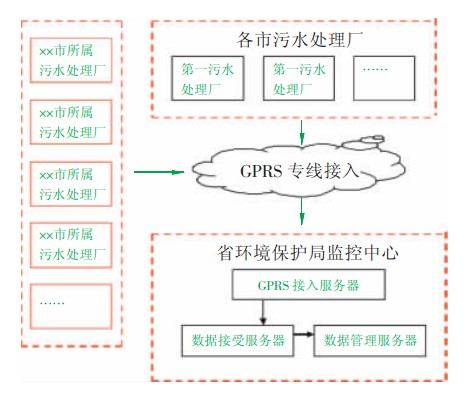Design and implementation of GPRS wireless data transmission monitoring system for provincial sewage treatment plant
Abstract: Taking Liaoning Environmental Information Center as an example, this paper introduces the provincial sewage treatment GPRS wireless data transmission monitoring system, which uses GPRS (General Packet Radio Service) wireless transmission technology to monitor the sewage treatment of sewage treatment plants in the province. The system will monitor the monitoring instruments of sewage treatment plants in real time, The data sent from the monitor to the PLC collector is uploaded to the provincial sewage treatment monitoring center through wireless transmission. In the monitoring center, the data can be monitored in real time, the monitoring instruments and equipment can be monitored, and the data can be processed, so that the pollution discharge supervision department can more timely, accurately, specifically and comprehensively grasp the number and information of environmental quality, environmental monitoring and key pollution sources in the province, In order to improve the rapid response ability of law enforcement, comprehensive supervision ability and scientific decision-making support ability.
1、 Introduction
The provincial sewage treatment GPRS wireless data transmission monitoring system adopts advanced and mature network data transmission equipment and advanced network data transmission technology to transmit the data of multiple monitoring sub stations distributed in more than a dozen sewage treatment plants in Liaoning Province to the monitoring center of the provincial Environmental Protection Bureau, so as to gradually establish an on-line sewage treatment monitoring network throughout the province, Provide real-time, accurate, specific and comprehensive quality and monitoring data information for the sewage treatment supervision of the whole province.
2、 System composition
The provincial sewage treatment GPRS wireless data transmission monitoring system is composed of data collector, GPRS wireless transmission and data management system (Figure 1), The data collector adopts 8-channel input signal GPRS data collector to collect the analog signal of voltage or current output by the on-line monitoring equipment and transmit it to the monitoring center through the equipment. In order to solve the problems existing in data transmission, GPRS data transmission adopts wireless data upload, The GPRS network provided by GPRS equipment and mobile communication is used to realize the wireless real-time upload of data and ensure the stability of data transmission. The data management system realizes the storage, statistics and analysis of the uploaded data, and realizes the performance and analysis of different ways, such as single parameter and multi parameter real-time data of different monitoring sub stations, statements and daily charts of hourly data and daily data, Provide users with accurate statistical analysis results.

Figure 1 provincial sewage treatment GPRS wireless data transmission monitoring system
3、 Data collector
3.1. Features
(1) The physical layer RS232, RS-422 and RS485 realize the digital communication (ASCII) between each communication port of the universal monitoring data collector and various online monitors according to different protocols.
(2) Realize 8 channels of 0 ~ 5V, 1 ~ 5V, 0 ~ 10mA or 4 ~ 20mA data acquisition of general monitoring data collector.
3.2 functions and parameters
(1) According to the time required by the user, collect data, store data and process data regularly, and transfer them to the upper microcomputer or the designated information system; The collected and processed data can be transmitted to another microcomputer or information system in ASCII format through another communication interface of the data collector.
(2) The system can collect 8 channels of 0 ~ 10mA or 4 ~ 20mA sensor information at the same time, or the online monitor can output 0 ~ 10mA or 4 ~ 20mA information (including 0 ~ 5V and 1 ~ 5V). The 0 ~ 10mA or 4 ~ 20mA (0 ~ 5V or 1 ~ 5V) hardware circuit can be switched through the jumper on the circuit board. The data collector can be suitable for 0 ~ 10mA or 4 ~ 20mA data connection output by various 0 ~ 10mA or 4 ~ 20mA sensors or online monitors.
(3) The data acquisition instrument has four RS-232 ports, two RS-422 ports and one RS-485 port. In addition, one RS-232 port connection adapter or other standard equipment is specially provided. The user can access and set each of the above 7 communication interfaces through the microcomputer, and can set the name of the online monitor (COD meter, pH meter, sewage flowmeter, etc.), communication command, baud rate, communication bits, data structure, etc. (the data bytes shall be ASCII code).
(4) The data collector provides 512k storage space to ensure that at least 3D data can be saved. The data is saved every certain time to ensure that the data will not be lost in case of power failure.
4、 GPRS data transmission
4.1gprs introduction
GPRS is a standard for packet data in the GSM system of the European Telecommunications Association. It can provide an air interface transmission rate of up to 115kbps. GPRS enables several mobile users to share a wireless channel at the same time, and a mobile user can also use multiple wireless channels. With GPRS, the call establishment time of users is greatly shortened, and they can almost be "always online". In fact, even users who are always online and do not send or receive packets account for only a small part of network resources. In addition, GPRS enables operators to charge based on the amount of data transmitted rather than the connection time, so as to reduce the service cost of each user. GPRS uses channel bundling and enhanced data rate to realize high-speed access. At present, GPRS design can realize bundling in one carrier frequency or eight channels, and increase the transmission rate of each channel to 14.4kbps. Therefore, the maximum rate of GPRS mode is 8 × 14.4=115.2Kbps。 The next step in the development of GPRS is to increase the rate of each channel to 48kbps through enhanced data rate improvement (edge), so the design rate of the second generation GPRS is 384kbps.
4.2gprs features
4.2.1 wide application
The preferred way for users should be to connect seamlessly with the network, regardless of time and place. All existing applications based on TCP / IP protocol can run well on GPRS system, just like connecting to local area network (LAN).
4.2.2 quick login
The new grouping service eliminates the long-time dialing and connection establishment process in the past. As long as the GPRS application is activated, it only takes 2S for each connection and will remain online forever. There is no drop problem, which is similar to a wireless private line network.
4.2.3 billing by volume
Although you can stay online forever, you don't have to worry about the cost, because you only charge when traffic is generated. It is a way of charging according to the user's data transmission traffic, which is more scientific and reasonable.
4.2.4 high speed transmission
The maximum theoretical transmission rate of GPRS is 115.2kbps. At present, GPRS can support a transmission rate of about 40kbps.
4.2.5 scalability
The scalable modular design structure enables the packet data processing capacity of GSM system to meet the needs of data transmission traffic. It allows the GSM system with low cost and small capacity to expand its capacity by adding new hardware and updating software, while only minor changes need to be made to the existing hardware. To sum up, the adoption of GPRS transmission scheme is the guarantee to ensure the flexibility, efficiency, economic rationality and scalability of the whole system, and can reduce the difficulty of system promotion.
5、 Data management system
Online monitoring data transmission system is a system for receiving, storing, managing, statistics and analysis of monitoring data. The system consists of two parts: server and client.
5.1 working principle of software
(1) The data collector of each monitoring sub station transmits the collected real-time data to the server of the monitoring center of the application department through GPRS equipment and GPRS network;
(2) The program installed on the server automatically stores the received data in the database;
(3) The programs of clients installed in different locations can obtain the data of corresponding monitoring sub stations according to their different permissions through the internal LAN;
(4) Real time data, hourly data, daily data, reports and analysis charts can be obtained through the functions provided by the client;
(5) The real-time data monitoring information of a certain point can be received at any time through mobile phone SMS.
5.2. Server side
The main functions are:
(1) Online site settings. Set the name, address, address number, ID number, etc. of the online site.
(2) Real time data. You can view the data of each monitoring sub station.
(3) Online users. You can view users who are currently online.
(4) Permission settings. Set permissions for different users to view data of different subsites.
5.3 client
The main function is to generate various reports and charts, including single station multi parameter, multi station single parameter and multi station multi parameter. In addition, there are real-time data viewing, hourly data viewing, report preview printing, data query and other functions.
In the LAN where the monitoring center is located, any authorized terminal can view real-time or historical data. The data is displayed according to geographical location, which is intuitive and clear.
The whole system has completed the complete monitoring data management system from the monitoring sub station to the provincial sewage treatment monitoring center to the clients of the monitoring center. Provide comprehensive, accurate and timely monitoring for users
At the same time, the monitoring data can be uploaded to the superior management department as needed.
6、 System working principle
This solution makes full use of the network conditions provided by mobile communication, and uses data acquisition equipment and GPRS equipment for data transmission, so as to ensure the stability of the network and the fast, timely and accurate data transmission. Through this system, multiple monitoring stations can be monitored in real time, so that the monitoring instrument data of each station can be displayed on the host of the monitoring center in real time. The data collector is designed to receive the data of multiple monitoring instruments and send the data to the GPRS network using a special GPRS wireless modem, Then upload it to the monitoring center of the provincial Environmental Protection Bureau through the internet-net backbone network (or GPRS network special line), and carry out real-time monitoring, monitoring and management in the monitoring center. Each site information monitoring station is equipped with a data collector and a GPRS wireless modem. The modem is connected with the data collector through RS-232 interface. The data collector is connected with the site online monitoring instruments (such as sewage, flow, pressure and other monitors), and collects and uploads data at a certain time interval, And monitor the uploaded data and the operation status of the instrument in real time. The GPRS wireless modem receives various instructions issued by the upper end, transmits them down to the data collector and online monitoring instrument, receives the data uploaded by the online monitoring instrument, packs the data without changing the data format, and sends the collected data to the GPRS network. GPRS network is uploaded to the monitoring center through the Internet backbone network (or GPRS network dedicated line). The monitoring center displays, stores and analyzes all kinds of data in real time, and automatically generates the required reports, realizing the purpose of real-time monitoring of information. The monitoring center can issue instructions through the management software and send them to the monitoring station and each monitoring instrument by GPRS wireless modem and data collector. It can set the parameters of the monitoring station, instrument control, communication mode, etc.
7、 Conclusion
The construction of wireless data transmission monitoring system of provincial sewage treatment plants enables relevant provincial decision-making departments to grasp the data and information of pollutant discharge of sewage treatment enterprises in the province in a more timely, accurate, specific and comprehensive manner, so as to provide technical support for strengthening management. Integrate existing resources, give full play to and maximize the role of existing networks and monitoring equipment, so that the existing sewage treatment quality monitoring data in the province can be used in real time and comprehensively in the province. The data analysis function of provincial sewage treatment monitoring center can provide technical support for scientific decision-making.

 Manager Wang
Manager Wang
 OfficialAccounts
OfficialAccounts